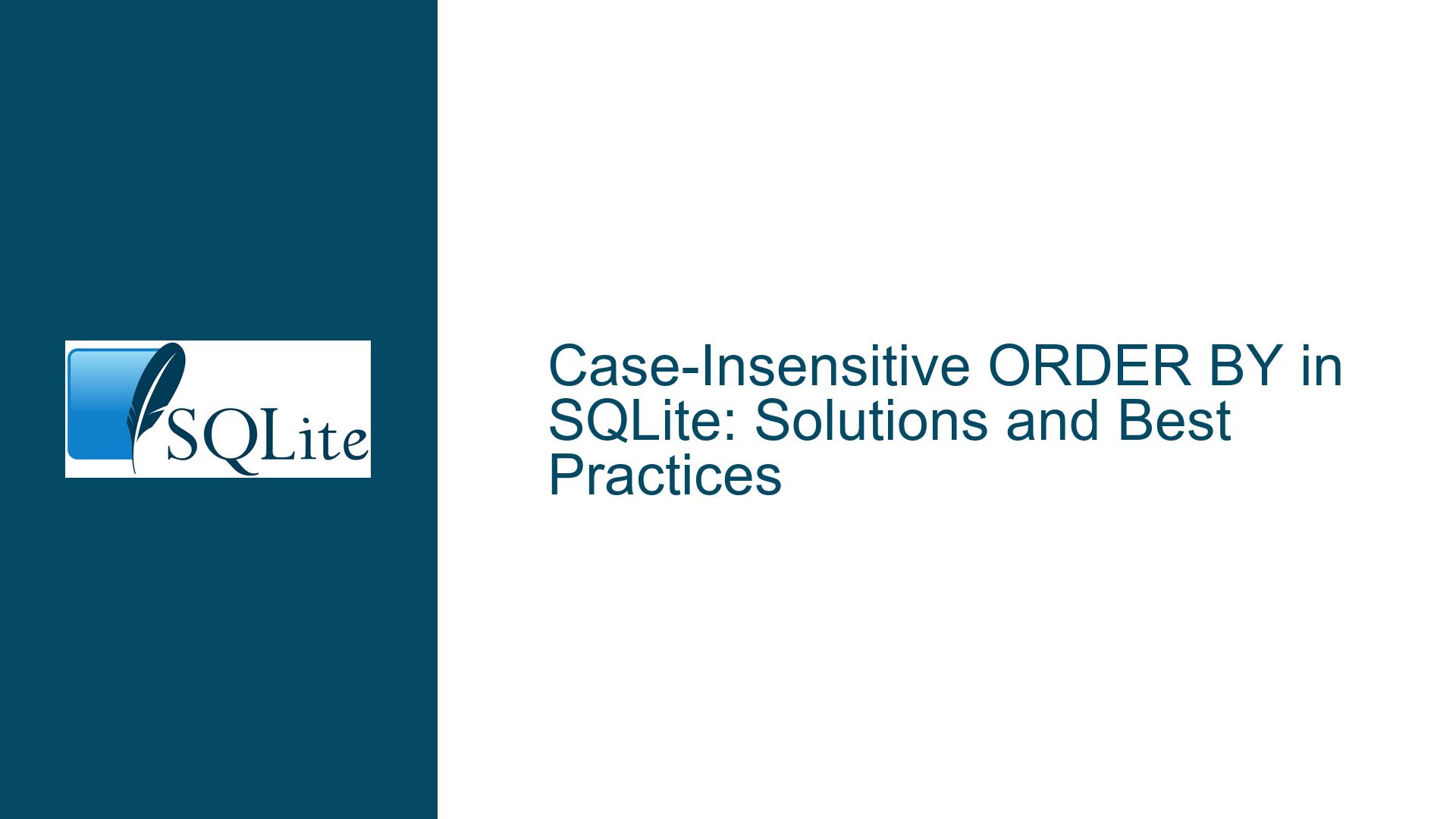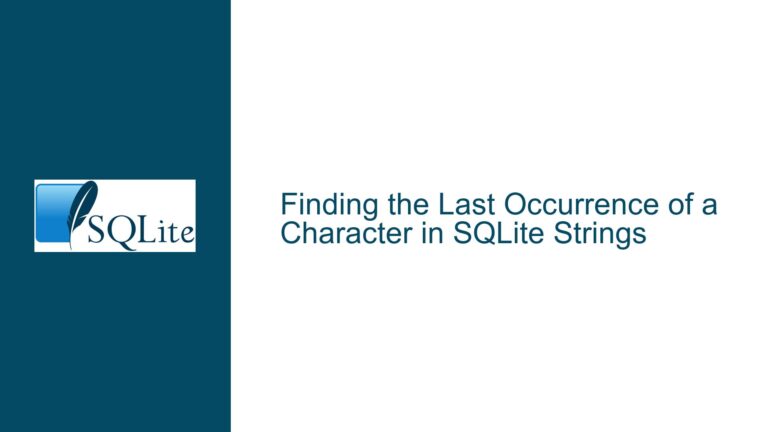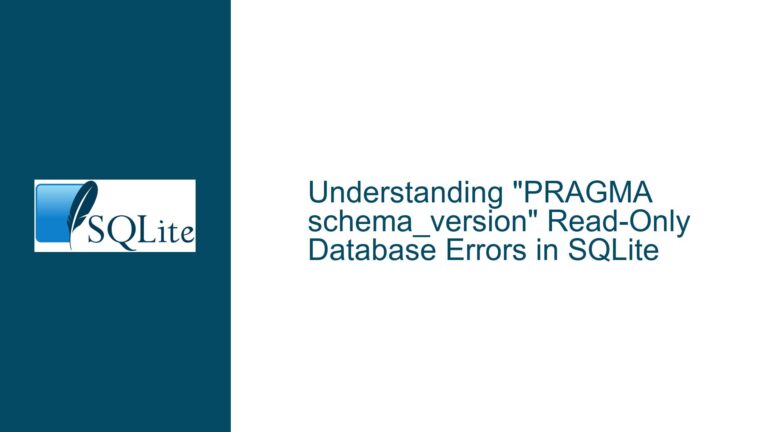Case-Insensitive ORDER BY in SQLite: Solutions and Best Practices
Case-Insensitive Sorting Challenges in SQLite Queries
When working with SQLite, one common challenge that developers encounter is achieving case-insensitive sorting when using the ORDER BY clause. By default, SQLite uses a binary collation sequence for text data, which means that sorting is case-sensitive. This can lead to unexpected results when querying data, especially when the dataset contains mixed-case text. For example, a query like SELECT name FROM artists ORDER BY name ASC might return results where "Zero 7" appears before "dZihan & Kamien" due to the ASCII values of the characters, even if the user expects a case-insensitive sort.
The issue becomes more pronounced when dealing with datasets that include names, titles, or other text fields where case sensitivity is not meaningful. For instance, in a music database, users might expect "VA Hed Music" and "va hed music" to be treated as equivalent during sorting. However, without explicit handling, SQLite will treat these as distinct values, leading to a sorting order that may not align with user expectations.
The confusion often arises from the fact that SQLite provides a case_sensitive_like pragma, which controls the behavior of the LIKE operator but does not affect the ORDER BY clause. This pragma, when set to 1, ensures that the LIKE operator performs case-sensitive comparisons. However, this setting has no bearing on the collation sequence used by ORDER BY. As a result, developers may mistakenly assume that enabling case_sensitive_like will also make ORDER BY case-insensitive, which is not the case.
To address this issue, SQLite offers collation sequences, which define how text values are compared and sorted. The default collation sequence is BINARY, which performs a byte-by-byte comparison of the text data. For case-insensitive sorting, SQLite provides the NOCASE collation sequence, which treats uppercase and lowercase letters as equivalent for comparison purposes. However, this collation sequence must be explicitly specified either in the table definition or within the query itself.
Collation Sequences and Their Impact on Sorting Behavior
Collation sequences in SQLite are rules that determine how text values are compared and sorted. The default collation sequence, BINARY, compares text data based on the underlying byte values. This means that uppercase letters (e.g., ‘A’) are treated as distinct from their lowercase counterparts (e.g., ‘a’) because they have different ASCII or Unicode values. While this behavior is efficient and predictable, it is not always desirable, especially when dealing with human-readable text where case sensitivity is irrelevant.
The NOCASE collation sequence, on the other hand, performs case-insensitive comparisons. When this collation sequence is applied, SQLite treats uppercase and lowercase letters as equivalent. For example, "Apple" and "apple" would be considered equal when using the NOCASE collation. This behavior is particularly useful for sorting operations, as it ensures that text data is ordered in a way that aligns with user expectations.
To use the NOCASE collation sequence, it must be explicitly specified. This can be done in one of two ways: by defining it at the column level when creating a table or by applying it directly within a query. When defined at the column level, the NOCASE collation sequence becomes the default for that column, and all subsequent queries involving that column will use it unless overridden. For example, the following table definition ensures that the name column uses case-insensitive sorting by default:
CREATE TABLE artists (
artistid INTEGER PRIMARY KEY,
name TEXT NOT NULL COLLATE NOCASE,
title TEXT
);
In this example, any query that sorts or compares the name column will automatically use the NOCASE collation sequence. This approach is ideal when case-insensitive behavior is required for all operations involving the column.
However, there are situations where case-insensitive sorting is only needed for specific queries. In such cases, the NOCASE collation sequence can be applied directly within the query using the COLLATE keyword. For example, the following query sorts the name column in a case-insensitive manner without modifying the table definition:
SELECT name, title
FROM artists
JOIN cds ON artists.artistid = cds.artistid
WHERE cds.genre LIKE 'Amb%'
ORDER BY name COLLATE NOCASE, title;
This approach provides flexibility, allowing developers to choose case-insensitive sorting on a per-query basis. It is particularly useful when working with existing databases where modifying the table schema is not feasible.
It is worth noting that the NOCASE collation sequence is not the only option available in SQLite. Developers can also define custom collation sequences using the sqlite3_create_collation() function in the SQLite C API. This allows for highly specialized sorting and comparison behaviors tailored to specific use cases. However, for most applications, the built-in NOCASE collation sequence is sufficient.
Implementing Case-Insensitive Sorting in SQLite Queries
To implement case-insensitive sorting in SQLite, developers must explicitly specify the NOCASE collation sequence either at the column level or within the query. The choice between these approaches depends on the specific requirements of the application and the existing database schema.
Defining Collation at the Column Level
When creating a new table, the NOCASE collation sequence can be specified for text columns that require case-insensitive sorting. This approach ensures that all queries involving the column will use the specified collation sequence by default. For example, consider the following table definition:
CREATE TABLE artists (
artistid INTEGER PRIMARY KEY,
name TEXT NOT NULL COLLATE NOCASE,
title TEXT
);
In this example, the name column is defined with the NOCASE collation sequence. As a result, any query that sorts or compares the name column will automatically use case-insensitive behavior. This approach is ideal for new databases or when modifying the schema of an existing database is feasible.
Applying Collation Within a Query
For existing databases where modifying the schema is not an option, the NOCASE collation sequence can be applied directly within the query using the COLLATE keyword. This approach provides flexibility and allows developers to implement case-insensitive sorting on a per-query basis. For example, consider the following query:
SELECT name, title
FROM artists
JOIN cds ON artists.artistid = cds.artistid
WHERE cds.genre LIKE 'Amb%'
ORDER BY name COLLATE NOCASE, title;
In this query, the ORDER BY clause specifies the NOCASE collation sequence for the name column. This ensures that the results are sorted in a case-insensitive manner without requiring any changes to the underlying table schema. This approach is particularly useful when working with legacy databases or when case-insensitive sorting is only needed for specific queries.
Performance Considerations
While the NOCASE collation sequence provides the desired case-insensitive sorting behavior, it is important to consider its impact on query performance. Collation sequences affect how indexes are used and can influence the efficiency of sorting and comparison operations.
When the NOCASE collation sequence is defined at the column level, SQLite can create indexes that use this collation sequence. This allows for efficient sorting and searching operations, as the index is already optimized for case-insensitive comparisons. For example, the following index definition uses the NOCASE collation sequence:
CREATE INDEX idx_artists_name ON artists (name COLLATE NOCASE);
This index can significantly improve the performance of queries that involve sorting or filtering by the name column. However, if the NOCASE collation sequence is only applied within a query, SQLite may not be able to use existing indexes efficiently, leading to slower performance. In such cases, it may be necessary to create additional indexes that explicitly use the NOCASE collation sequence.
Best Practices
To ensure optimal performance and maintainability, developers should follow these best practices when implementing case-insensitive sorting in SQLite:
Define Collation at the Column Level When Possible: Specifying the
NOCASEcollation sequence at the column level ensures consistent behavior across all queries and allows for efficient indexing. This approach is recommended for new databases or when modifying the schema is feasible.Use the
COLLATEKeyword for Specific Queries: When working with existing databases, apply theNOCASEcollation sequence within the query using theCOLLATEkeyword. This approach provides flexibility without requiring schema changes.Create Indexes with the Appropriate Collation Sequence: To optimize query performance, create indexes that use the
NOCASEcollation sequence for columns that require case-insensitive sorting. This ensures that sorting and comparison operations are efficient.Consider Custom Collation Sequences for Specialized Needs: For applications with unique sorting requirements, consider defining custom collation sequences using the SQLite C API. This allows for highly specialized behavior tailored to specific use cases.
By following these best practices, developers can effectively implement case-insensitive sorting in SQLite while maintaining optimal performance and ensuring a consistent user experience.






